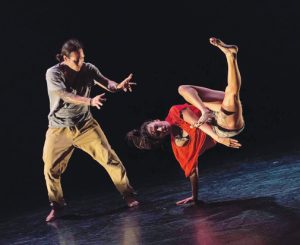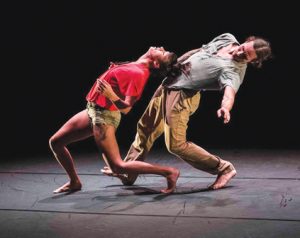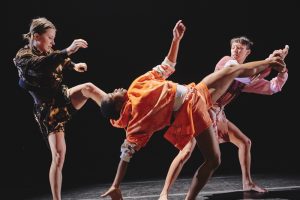Kindred Hip-hop Spirits: Tentacle Tribe’s Elon Höglund and Emmanuelle Lê Phan - Vancouver Ballet Society
- Home
- Features 2015 - 2019
- Kindred Hip-hop Spirits: Tentacle Tribe’s Elon Höglund and Emmanuelle Lê Phan

by Victor Swoboda
Despite having only a few works in the repertoire since being founded five years ago, the small Montreal troupe called Tentacle Tribe is nonetheless in the forefront of the city’s emerging companies. Co-artistic directors Elon Höglund of Sweden and Emmanuelle Lê Phan of Ottawa draw choreographic inspiration from hip hop, breakdance and martial arts, transforming these pop culture forms into shapes that have emotional depth and philosophical reflection.

Photo: Panda
Höglund and Lê Phan, both 36, are accomplished breakdancers and hip-hop artists who had worked together previously at Cirque du Soleil, Cirque Éloize and Rubberbandance. A chance offer to create a duet for the 2012 edition of Short and Sweet, a show of three-minute works on a small Montreal stage, brought the duo to the attention of the director of the summer dance series Quartiers Danses. Under their newly named company, Tentacle Tribe, and with a distinctive octopus logo, Höglund and Lê Phan appeared at Quartiers Danses in a 10-minute duet, When They Fall.
Invited back the following year, they presented an extended version of the same piece at an outdoor venue downtown, accompanied by a live trumpeter. The 16-minute When They Fall Revisited had twisting limbs, interlocking bodies and controlled falls. The piece was enticing enough to encourage Pierre Des Marais, artistic director of the DanseDanse series, to invite Tentacle Tribe to perform at Montreal’s most prestigious arts showcase, Place des Arts. The gig and the accompanying publicity campaign were a boost for the young company.
For Danse Danse, Tentacle Tribe created Nobody Likes a Pixelated Squid, a 40-minute work whose complexity subverted hip-hop and breakdance moves into an overriding stylistic whole. Unlike breakdance or hip-hop battles where individual moves are praised for originality and virtuosity, Nobody Likes a Pixelated Squid drew meaning from the relations among the moves. In this way, the duo was able to show the attraction and repulsion of a developing male-female relationship. Locking and popping moves resonated emotionally.

Photo: Panda
Two years later, they pushed their discoveries further in the hour-long Fractals of You. Refining their dance vocabulary still more, they showed in gestures how two people can come under each other’s influence, moving at times at the will of one or the other, now in tandem, now out of step. With impressive elegance, the two executed some intricate partnering, donning, removing and exchanging knee-length trench coats as a kind of metaphor for the ways in which people in a relationship mark each other and then leave those traces behind.
Fractals of You unfolded by implication and suggestion, leaving it to the spectator to discover the many sides of the dance narrative. Although it was abstract, the piece had a carefully defined architecture so that its significance defied arbitrary interpretation.
Underlying Tentacle Tribe’s choreography is an understanding of aesthetics as the artistic resolution of opposites, a notion at the root of great works of art throughout history. For Höglund and LêPhan, it is the contrasting circular and angular patterns of geometry that provide a foundation.
“Sacred geometry tries to explain our world through geometry,” says Höglund. “The circle is the womb, feminine, creative, unpredictable. It also expresses chaos. Masculine energy is the square or angular shapes that are born out of feminine shapes. For me, it’s always been about opposition — how you combine masculine and feminine energies.”
Throughout Tentacle Tribe’s creations, the performers’ bodies are shown first in opposition to each other, then in harmony. What makes the works so rich is that the tension created by opposing forces is resolved in surprising ways. Höglund says: “I like subtlety. The beauty of our work is that the moves are unexpected.”

Photo: Panda
Moreover, the forces in opposition are not always seen in consecutive order. Sometimes an element introduced early in the piece stands in contrast with another element later on. As a consequence, works by Tentacle Tribe offer much to discover over multiple viewings.
Lê Phan’s and Höglund’s artistic awareness grew out of their personal histories and creative encounters. “My dad was a musician and my mom was an artist, so I always had a creative environment,” says Höglund, who grew up in Stockholm. “I’ve always been a physical person — my mom said I was dancing as a baby.”
At six, Höglund was running home from school to watch and imitate the moves in Michael Jackson’s Thriller video. A few years later, he became intrigued by two movies, Beat Street and Breaking, featuring B-boys and poppers. At 12, he met a pioneer Norwegian breakdancer, Bjorn Johannesen who taught him basic technique, showed him breakdance videos and took him to his first battles between breaking crews. For the next several years, Höglund taught himself breakdance while also pursuing taekwando, kung fu and capoeira.
“Most B-boys are self-taught,” says Höglund. “Technique is within us. It’s just studying and understanding your own body. I had injuries that made me learn, and I was lucky to meet people who gave me pointers on different techniques, like gymnastics, martial arts, breaking.”
His real hip-hop mentors were the members of Concrete Kingz, a Swedish breaking crew he joined in 1999. His peers encouraged him to audition for a show that Cirkus Cirkör was planning at the Royal Dramatic Theatre in Stockholm, a wild mix of aerials, dance and gymnastics.
“I remember the day of the audition very clearly because I had stage fright. I said to my self, ‘Either you try it or you don’t.’ So I put fear aside.” When they hired him, he says, “It ignited a new purpose. I started learning aerial acrobatics, contemporary dance, training more seriously and thoughtfully.”
His performance drew an offer to audition for Cirque du Soleil, but Höglund felt it was too early. Only after freelancing for five years in various circus and dance gigs in Scandinavia did he reconsider the Cirque’s proposal to try out in Montreal. “I was there for a week, tried many things, and first met Emmanuelle. She was a kindred spirit, also mixing forms.

Lê Phan had moved from Ottawa to Montreal to study dance at Concordia University and to taste the city’s vibrant dance scene. “As a child, I was hyperactive, but very shy. My mom put me in a lot of things — ballet, which I didn’t love, and jazz, which wasn’t me. I kind of liked modern dance and when I was 10 or 11, I went to the School of Dance in Ottawa. But there were no hip-hop classes.
Lê Phan entered the francophone De La Salle High School because of its strong dance and arts program. “I was so anti-social that I would sometimes not go for lunch and just stay in the studio and make choreographies.” School trips to the National Arts Centre revealed artists like Louise Lecavalier, who became Lê Phan’s idol, and Les ballets C de la B, which she dreamed of joining. In her final high school year, Lê Phan attended raves. “I discovered breaking and thought, ‘Oh, I need to do this!’”
She started breaking outside school, formed a small female crew called Upside Squad and participated in battles in Ottawa’s fledgling breaking scene as well as at bigger competitions like the B-boys’ Pro-Am. “Two guys from a group called Canadian Floor Masters taught me basics like the six step, but that was it. I often watched VHS tapes, fast-forwarding and rewinding. I wanted to learn other styles, but there were no locking or popping classes.”

By necessity, Lê Phan, like Höglund, had to develop a personal technique and style largely on her own. “It was like that for our generation, but now there are schools for learning hip hop,” says Höglund, who feels he has learned from everyone he has ever worked with. One lesson in particular stays with him. “It’s never good to be negative about yourself. I trained a lot and would be unhappy if I didn’t master something. Later, I learned that if you train, you should just be happy that you did something.”
At Concordia, Lê Phan studied dance under Sylvie Panet-Raymond. “She helped me a lot and steered me toward choreography where I thought about how to integrate breaking.” A Montreal B-boy was her boyfriend at the time. “He was very power driven, which is where I got my power. His group, Tactical Crew, performed in the Just for Laughs festival and in street shows. I loved battling — we went to Toronto, San Diego. The scene was very exciting.”
In 2003, LêPhan joined a new company called Rubberbandance, whose founder, Victor Quijada, had a varied background in breaking and contemporary ballet. Over the next decade, Rubberbandance became a major troupe with a distinctive style that emphasized off-centre moves and intricate interplay of limbs. Quijada, with dancer and co-artistic director Anne Plamondon, used hip hop and breaking as the basis for a refined vocabulary that could sustain a lengthy choreography.
During the 2000s, Lê Phan was also an integral part of Montreal’s first all-girl hip-hop troupe, Solid State. Bringing together as many as 14 B-girls, Solid State’s shows had exuberant energy and daring that compensated for the somewhat raw quality of its choreographies.
“After seeing me in Rubberbandance’s Slicing Static,” says Lê Phan, “a Cirque du Soleil director asked for a video, so I sent him a 17-minute demo. Cirque auditions can be cattle calls, but mine had only about 15 people.” Around the same time, Höglund was also auditioning for Cirque du Soleil; both were successful.

In Las Vegas, Lê Phan and Höglund performed in Cirque’s Love show 10 times a week. Höglund, recalls Lê Phan, had an “amazing solo, a mix of capoeira, acrobatics, contemporary dance and hip hop, with four women swinging overhead in harnesses.” Before and after shows, they worked on their own dances and style.
“There are so many performers [in Las Vegas] who do so many shows that they get tired of it,” says Lê Phan. “After a two-year contract, like many others we were ready to go on to something else.”
Back in Montreal, Lê Phan rejoined Rubberbandance and Höglund followed her, dancing in 2011 in Quijada’s Gravity of Center. “Most of my career, I created my own work. I thought it might be interesting to be in a company where I was an interpreter,” says Höglund. “Rubberbandance has more ballet influences than my work, but their approach is similar. It was an easy transfer.” Lê Phan and Höglund did just one Rubberbandance show together, as well as one with Cirque Éloize before going out on their own.
In the years since its founding, Tentacle Tribe has performed in Canada, the United Kingdom, France, Mexico and Sweden. Lê Phan and Höglund also hold workshops and creation sessions. “Our classes are about body-and-mind connections, playing with oppositions, angles, finding circular movements, popping, isolation,” says Höglund.
Tentacle Tribe expanded to a quartet in 2017, when Victoria Mackenzie and Marie-ReineKabasha performed with Lê Phan on a tour of her trio, Origami Mami, which included London, England. The company grew further for a sextet called Threesixnine, which premiered at the 2017 Festival des Arts de Saint-Sauveur in August.
The founding duo hopes to expand to the point where Tentacle Tribe can have two separate groups. “Either Emmanuelle or I will always perform in a work,” says Höglund, “but we’d like to teach new dancers the old works and have two touring companies.” Having more dancers, they feel, will allow them to devote more time to creation.

Photo: Alexandre Gilbert
